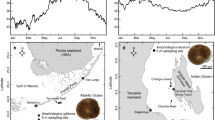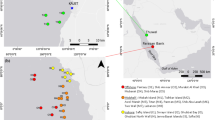Abstract
Intertidal organisms commonly form zonation bands along the shore. Environmental stressors often determine the vertical position of each zonation band. These stressors may similarly affect the distribution pattern of endogenous species in their intertidal hosts. To evaluate this possibility, we investigated the distribution pattern of endosymbiotic zooxanthellae in the genus Symbiodinium in a population of the intertidal sea anemone Anthopleura uchidai. We used molecular genetics to identify the Symbiodinium clades and found that A. uchidai has two clades of Symbiodinium, clades A and F. These Symbiodinium clades were disproportionally distributed along the vertical gradient of the intertidal shore. Anemones on the upper shore exclusively possessed clade F Symbiodinium while clade A Symbiodinium became dominant in the sea anemones on the lower shore. Photosynthesis activity assays showed that these Symbiodinium clades had similar net productivities at 23.3 and 31.8 °C at all irradiance levels. At 35 °C, however, clade A Symbiodinium exhibited substantially lower net productivities than clade F Symbiodinium, demonstrating that these Symbiodinium clades have distinct tolerances to thermal stress. These results suggest that the thermal gradient across tidal height is a major factor shaping the zonation pattern of Symbiodinium clades in A. uchidai.





Similar content being viewed by others
References
Bates A (2000) The intertidal distribution of two algal symbionts hosted by Anthopleura xanthogrammica (Brandt 1835). J Exp Mar Biol Ecol 249:249–262
Chavanich S, Wilson KA (2000) Rocky intertidal zonation of gammaridean amphipods in Long Island Sound, Connecticut. Crustaceana 73:835–846
Connell JH (1972) Community interactions on marine rocky intertidal shores. Annu Rev Ecol Syst 3:169–192
Curtis LA (1987) Vertical distribution of an estuarine snail altered by a parasite. Science 235:1508–1511
Doyle JJ, Doyle JL (1987) A rapid DNA isolation procedure for small amounts of fresh leaf tissue. Phytochem Bull 19:11–15
Finney JC, Pettay DT, Sampayo EM, Warner ME, Oxenford HA, LaJeunesse TC (2010) The relative significance of host-habitat, depth, and geography on the ecology, endemism, and speciation of coral endosymbionts in the genus Symbiodinium. Microb Ecol 60:250–263
Geller JB, Walton ED (2001) Breaking up and getting together: evolution of symbiosis and cloning by fission in sea anemones (genus Anthopleura). Evolution 55:1781–1794
Goulet TL, Cook CB, Goulet D (2005) Effect of short-term exposure to elevated temperatures and light levels on photosynthesis of different host-symbiont combinations in the Aiptasia pallidal Symbiodinium symbiosis. Limnol Oceanogr 50:1490–1498
Haylor GS, Thorpe JP, Carter MA (1984) Genetic and ecological differentiation between sympatric colour morphs of the common intertidal sea anemone Actinia equina. Mar Ecol Prog Ser 16:281–289
Jones A, Berkelmans R (2010) Potential costs of acclimatization to a warmer climate: growth of a reef coral with heat tolerant vs. sensitive symbiont types. PLoS ONE 5:e10437
Kemp D, Fitt W, Schmidt G (2008) A microsampling method for genotyping coral symbionts. Coral Reefs 27:289–293
LaJeunesse TC (2002) Diversity and community structure of symbiotic dinoflagellates from Caribbean coral reefs. Mar Biol 141:387–400
LaJeunesse TC, Pettay DT, Sampayo EM, Phongsuwan N, Brown B, Obura DO, Hoegh-Guldberg O, Fitt WK (2010) Long-standing environmental conditions, geographic isolation and host–symbiont specificity influence the relative ecological dominance and genetic diversification of coral endosymbionts in the genus Symbiodinium. J Biogeogr 37:785–800
LaJeunesse TC, Parkinson JE, Reimer JD (2012) A genetics-based description of Symbiodinium minutum sp. nov. and S. psygmophilum sp. nov. (Dinophyceae), two dinoflagellates symbiotic with cnidaria. J Phycol 48:1380–1391
Lewis JR (1978) The ecology of rocky shores. Hodder and Stoughton, London
Little AF, Van Oppen MJH, Willis BL (2004) Flexibility in algal endosymbioses shapes growth in reef corals. Science 304:1492–1494
Luckens PA (1975) Competition and intertidal zonation of barnacles at Leigh, New Zealand. N Z J Mar Freshwat Res 9:379–394
Miura O, Chiba S (2007) Effects of trematode double infection on the shell size and distribution of snail hosts. Parasitol Int 56:19–22
Miura O, Kuris AM, Torchin ME, Hechinger RF, Chiba S (2006) Parasites alter host phenotype and may create a new ecological niche for snail hosts. Proc R Soc Lond B 273:1323–1328
Monteiro FA, Solé-Cava AM, Thorpe JP (1997) Extensive genetic divergence between populations of the common intertidal sea anemone Actinia equina from Britain, the Mediterranean and the Cape Verde Islands. Mar Biol 129:425–433
Mortain-Bertrand A, Descolas-Gros C, Jupin H (1988) Growth, photosynthesis and carbon metabolism in the temperate marine diatom Skeletonema costatum adapted to low temperature and low photon-flux density. Mar Biol 100:135–141
Mouritsen KN, Poulin R (2002) Parasitism, community structure and biodiversity in intertidal ecosystems. Parasitology 124:101–117
Ottaway JR (1973) Some effects of temperature, desiccation, and light on the intertidal anemone, Actinia tenebrosa Farquhar (Cnidaria: Anthozoa). Aust J Mar Freshw Res 24:103–126
Platt T, Gallegos CL, Harrison WG (1980) Photoinhibition of photosynthesis in natural assemblages of marine phytoplankton. J Mar Res 38:687–701
Pochon X, Gates RD (2010) A new Symbiodinium clade (Dinophyceae) from soritid foraminifera in Hawai’i. Mol Phylogen Evol 56:492–497
Pochon X, Pawlowski J, Zaninetti L, Rowan R (2001) High genetic diversity and relative specificity among Symbiodinium-like endosymbiotic dinoflagellates in soritid foraminiferans. Mar Biol 139:1069–1078
Robison JD, Warner ME (2006) Differential impacts of photoacclimation and thermal stress on the photobiology of four different phylotypes of Symbiodinium (pyrrhophyta). J Phycol 42:568–579
Rodriguez-Lanetty M, Chang SJ, Song JI (2003) Specificity of two temperate dinoflagellate–anthozoan associations from the north-western Pacific Ocean. Mar Biol 143:1193–1199
Rowan R, Knowlton N (1995) Intraspecific diversity and ecological zonation in coral-algal symbiosis. Proc Natl Acad Sci USA 92:2850–2853
Sall J, Creighton L, Lehman A (2007) JMP start statistics: a guide to statistics and data analysis using JMP. SAS Institute Inc., Cary
Schama R, Solé-Cava AM, Thorpe JP (2005) Genetic divergence between east and west Atlantic populations of Actinia spp. sea anemones (Cnidaria: Actiniidae). Mar Biol 146:435–443
Secord D, Augustine L (2000) Biogeography and microhabitat variation in temperate algal-invertebrate symbioses: zooxanthellae and zoochlorellae in two Pacific intertidal sea anemones, Anthopleura elegantissima and A. xanthogrammica. Invertebr Biol 119:139–146
Somero GN (2002) Thermal physiology and vertical zonation of intertidal animals: optima, limits, and costs of living. Integr Comp Biol 42:780–789
Sotka EE, Thacker RW (2005) Do some corals like it hot? Trends Ecol Evol 20:59–62
Stephenson TA, Stephenson A (1949) The universal features of zonation between tide-marks on rocky coasts. J Ecol 37:289–305
Suggett DJ, Warner ME, Smith DJ, Davey P, Hennige S, Baker NR (2008) Photosynthesis and production of hydrogen peroxide by Symbiodinium (Pyrrhophyta) phylotypes with different thermal tolerances. J Phycol 44:948–956
Tamura K, Peterson D, Peterson N, Stecher G, Nei M, Kumar S (2011) MEGA5: molecular evolutionary genetics analysis using maximum likelihood, evolutionary distance, and maximum parsimony methods. Mol Biol Evol 28:2731–2739
Thompson JD, Higgins DG, Gibson TJ (1994) CLUSTAL W: improving the sensitivity of progressive multiple sequence alignment through sequence weighting, position-specific gap penalties and weight matrix choice. Nucleic Acids Res 22:4673–4680
Uchida H, Soyama I (2001) Sea anemones in Japanese waters. TBS Britannica, Tokyo
Underwood AJ (1973) Studies on zonation of intertidal prosobranch molluscs in the Plymouth region. J Anim Ecol 42:353–372
Underwood AJ (1975) Intertidal zonation of prosobranch gastropods: analysis of densities of four co-existing species. J Exp Mar Biol Ecol 19:197–216
Venn AA, Loram JE, Trapido-Rosenthal HG, Joyce DA, Douglas AE (2008) Importance of time and place: patterns in abundance of Symbiodinium clades A and B in the tropical sea anemone Condylactis gigantea. Biol Bull 215:243–252
Warner ME, LaJeunesse TC, Robison JD, Thur RM (2006) The ecological distribution and comparative photobiology of symbiotic dinoflagellates from reef corals in Belize: potential implications for coral bleaching. Limnol Oceanogr 51:1887–1897
Yamada SB, Boulding EG (1996) The role of highly mobile crab predators in the intertidal zonation of their gastropod prey. J Exp Mar Biol Ecol 204:59–83
Acknowledgments
We thank K. Fukami for his valuable comments on this study. We also thank Y. Kumekawa, K. Matsuyama, K. Ohga, N. Yokoyama for their field assistance, and C. Keogh for English editing. Two anonymous reviewers provided useful comments. This study was performed through the Program to Disseminate Tenure Tracking System of the Ministry of Education, Culture, Sports, Science and Technology, the Japanese Government.
Author information
Authors and Affiliations
Corresponding author
Additional information
Communicated by M. Kühl.
Rights and permissions
About this article
Cite this article
Miura, O., Keawtawee, T., Sato, N. et al. Vertical zonation of endosymbiotic zooxanthellae within a population of the intertidal sea anemone, Anthopleura uchidai . Mar Biol 161, 1745–1754 (2014). https://doi.org/10.1007/s00227-014-2456-0
Received:
Accepted:
Published:
Issue Date:
DOI: https://doi.org/10.1007/s00227-014-2456-0




